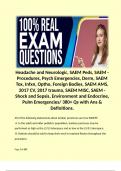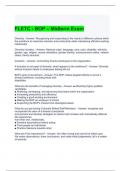Headache and Neurologic, SAEM Peds, SAEM -
Procedures, Psych Emergencies, Derm, SAEM
Tox, Infxn, Optho, Foreign Bodies, SAEM AMS,
2017 CV, 2017 trauma, SAEM MISC, SAEM -
Shock and Sepsis, Environment and Endocrine,
Pulm Emergencies/ 380+ Qs with Ans &
Definitions.
All of the following statements about lumbar punctures are true EXCEPT:
A. In the adult and older pediatric population, lumbar punctures may be
performed as high as the L2/L3 interspace and as low as the L5/S1 interspace.
B. Patients should be told to keep their neck in maximal flexion throughout the
procedure.
Page 1 of 241
,C. The subarachnoid space extends to the S2 vertebral level.
D. Patients are positioned in lateral recumbent position with their lower back
arched toward the physician.
E. In locating the puncture site, a line connecting the posterior superior iliac
crests will intersect the midline at approximately L4. - Answer: The answer is B.
Flexion of the neck does not facilitate the LP to any great extent and may add to a
patient's discomfort as well as compromise the unconscious patient's airway.
Typically, patients are positioned in the lateral recumbent position but an LP may
be performed in the upright seated position. This position may be desirable in the
pediatric population where the midline may be more difficult to identify (answer
A). Answers B, C, and E are all true statements regarding the anatomy relevant to
performing a lumbar puncture.
A 65 year old male with a past medical history of poorly controlled hypertension
presents with new onset unilateral arm and leg weakness. There is no disturbance
of consciousness and there is no evidence of cortical findings (such as aphasia,
agnosia, or hemianopsia). What is the most likely location of the vascular
obstruction?
A. posterior cerebral artery
B. middle cerebral artery
C. basilar artery
D. anterior cerebral artery
E. lacunar - Answer: The answer is E. Lacunar infarcts occur at the small, terminal
branches of the vasculature and more commonly occur in African-Americans and
patients with diabetes and hypertension. This patient's presentation, evidenced
Page 2 of 241
,by pure loss of motor function without disturbances in other neurological
modalities, is consistent with an infarct in the internal capsule. Because terminal
branches of the vasculature supply the internal capsule, it is frequently affected in
patients with diabetes and hypertension. A vascular obstruction in the MCA would
affect not only motor functions, but also produce cortical findings such as aphasia
or agnosia.
A 19 year old female college student presents to the emergency department with
fever, headache, and confusion. Physical exam reveals T103. She is lethargic. The
HEENT exam is normal, she has nuchal rigidity, and her lungs are clear. Of the
following choices, the next step in her treatment should be:
A. azithromycin IV
B. ceftriaxone IV
C. levofloxacin PO or IV
D. head CT
E. head CT, followed by lumbar puncture - Answer: The answer is B. In patients
with meningitis, early antibiotics administration is of the utmost importance.
Antibiotic administration should not be delayed to await diagnostic work up.
Ceftriaxone, administered in some regions with vancomycin depending on the
resistance profile of likely etiologic agents, is generally considered an antibiotic of
choice in meningitis. Azithromycin and levofloxacin do not have good CNS
penetration and therefore are not indicated for meningitis.
A 24 year old female without prior medical history presents with a one day history
of left sided facial weakness. It was preceded by a headache behind her left ear.
Page 3 of 241
, On exam she is unable to wrinkle her left forehead or close her left eye. The
corner of her mouth droops on the left. The rest of the exam is normal. Which of
the following would be inappropriate in the care of this patient?
A. CT of the brain with and without intravenous contrast.
B. Acyclovir.
C. Evaluation of Lyme disease if the patient lives in or has visited a Lyme endemic
area.
D. A short course of prednisone.
E. Protecting her left eye with moisturizing drops and a patch at bedtime. -
Answer: The answer is A. Bell's palsy is an idiopathic palsy of the facial nerve.
Although it is the most common cause of a facial nerve palsy, other etiologies
must be ruled out. Inability to move the forehead muscle indicates a peripheral
lesion, making stroke much less likely. If the remainder of the neurological exam is
normal, then imaging is not needed. Lyme disease is a well known cause of facial
nerve palsy and patients should be evaluated for this if they live in an endemic
region. Half of cases present with retroauricular pain around the time of onset.
Most neurologists recommend a short course of prednisone as part of treatment.
There is evidence that herpes simplex virus is involved as a causative agent, and
acyclovir is recommended. Also extremely important is to protect the involved
eye, as it is at risk of drying out because lacrimal gland functioning can be
impaired, and the eye is unable to close fully.
A 56 year old woman presents to the emergency department with a complaint
that "my head is spinning." For two days she has experienced a spinning sensation
periodically, one that she does not associate with any specific position or
Page 4 of 241





